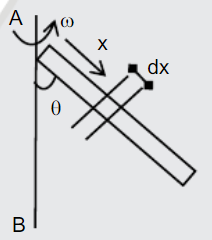A solid sphere is rotating about a diameter at an angular velocity . If it cools so that its radius reduces to of its original value, its angular velocity becomes
The correct Answer is:D
To solve the problem, we will use the principle of conservation of angular momentum. The angular momentum of a rotating object is given by the product of its moment of inertia and its angular velocity.
1. Identify Initial Parameters:
- Let the initial radius of the sphere be R.
- The initial angular velocity is ω.
- The mass of the sphere is m.
2. Calculate Initial Moment of Inertia:
- The moment of inertia I of a solid sphere about its diameter is given by:
I=25mR2
- Thus, the initial angular momentum Li can be expressed as:
Li=I⋅ω=25mR2⋅ω
3. Determine Final Parameters:
- The radius of the sphere reduces to Rn.
- The final angular velocity is ωf.
4. Calculate Final Moment of Inertia:
- The final moment of inertia If when the radius is Rn is:
If=25m(Rn)2=25mR2n2
- The final angular momentum Lf can be expressed as:
Lf=If⋅ωf=25mR2n2⋅ωf
5. Apply Conservation of Angular Momentum:
- Since there is no external torque acting on the system, we can set the initial angular momentum equal to the final angular momentum:
Li=Lf
- Substituting the expressions for Li and Lf:
25mR2⋅ω=25mR2n2⋅ωf
6. Simplify the Equation:
- The 25mR2 terms cancel out from both sides:
ω=1n2⋅ωf
7. Solve for Final Angular Velocity:
- Rearranging gives:
ωf=n2⋅ω
Final Answer:
The final angular velocity ωf becomes:
ωf=n2⋅ω
- Let the initial radius of the sphere be R.
- The initial angular velocity is ω.
- The mass of the sphere is m.
- The moment of inertia I of a solid sphere about its diameter is given by:
I=25mR2
- Thus, the initial angular momentum Li can be expressed as:
Li=I⋅ω=25mR2⋅ω
- The radius of the sphere reduces to Rn.
- The final angular velocity is ωf.
- The final moment of inertia If when the radius is Rn is:
If=25m(Rn)2=25mR2n2
- The final angular momentum Lf can be expressed as:
Lf=If⋅ωf=25mR2n2⋅ωf
- Since there is no external torque acting on the system, we can set the initial angular momentum equal to the final angular momentum:
Li=Lf
- Substituting the expressions for Li and Lf:
25mR2⋅ω=25mR2n2⋅ωf
- The 25mR2 terms cancel out from both sides:
ω=1n2⋅ωf
- Rearranging gives:
ωf=n2⋅ω
The final angular velocity ωf becomes:
ωf=n2⋅ω
Similar Questions
A circular disc is rotating about its own axis at an angular velocity ω. If P is exact midpoint of dise between axis and rim of disc then angular velocity of Pis
View SolutionA circular disc is rotating about its own axis at uniform angular velocity ω. The disc is subjected to uniform angular retardation by which its angular velocity is decreased to ω/2 during 120 rotations., The number of rotations further made by it before coming to rest is
View SolutionA solid sphere is rotating with a constant angular velocity about an axis touching the surface. Its angular momentum will be:
View SolutionA thin circular ring of mass M and radius R is rotating about its axis with constant angular velocity ω. The objects each of mass m are attached gently to the ring. The wheel now rotates with an angular velocity.
View SolutionA rod is rotating with angular velocity ω about axis AB. Find cosθ.
 View Solution
View SolutionA fly wheel is rotating about its own axis at an angular velocity 11rads−1, its angular velocity in revolution per minute is
View SolutionA wheel is rotating about its axis at a constant angular velocity. If suddenly an object sticks to it on the rim, then its M.I. will:
View SolutionIf 2 kg mass is rotating on a circular path of radius 0.8 m with angular velocity of 44 rad/sec. If radius of the parth becomes 1 m, then what will be the value of angular velocity?
View SolutionA solid sphere of radius r and mass m rotates about an axis passing through its centre with angular velocity ω. Its K.E. Is
View SolutionA conducting circular loop of radius r is rotated about its diameter at a constant angular velocity ω in a magnetic field B perpendicular to the axis of rotation. In what position of the loop is the induced emf zero?
View Solution

